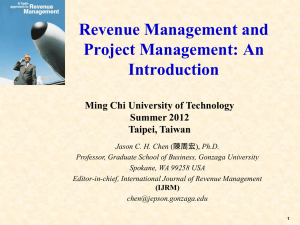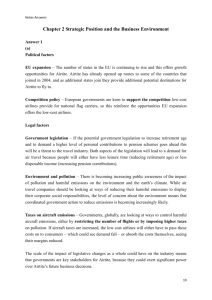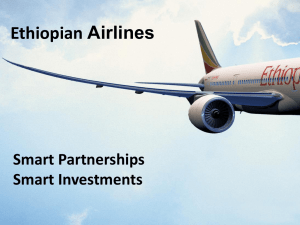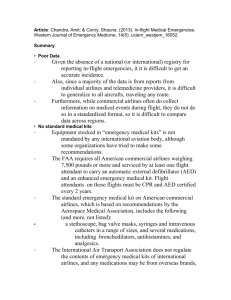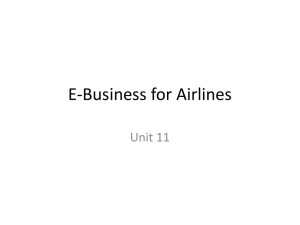Trouble in the air, double on the ground
advertisement
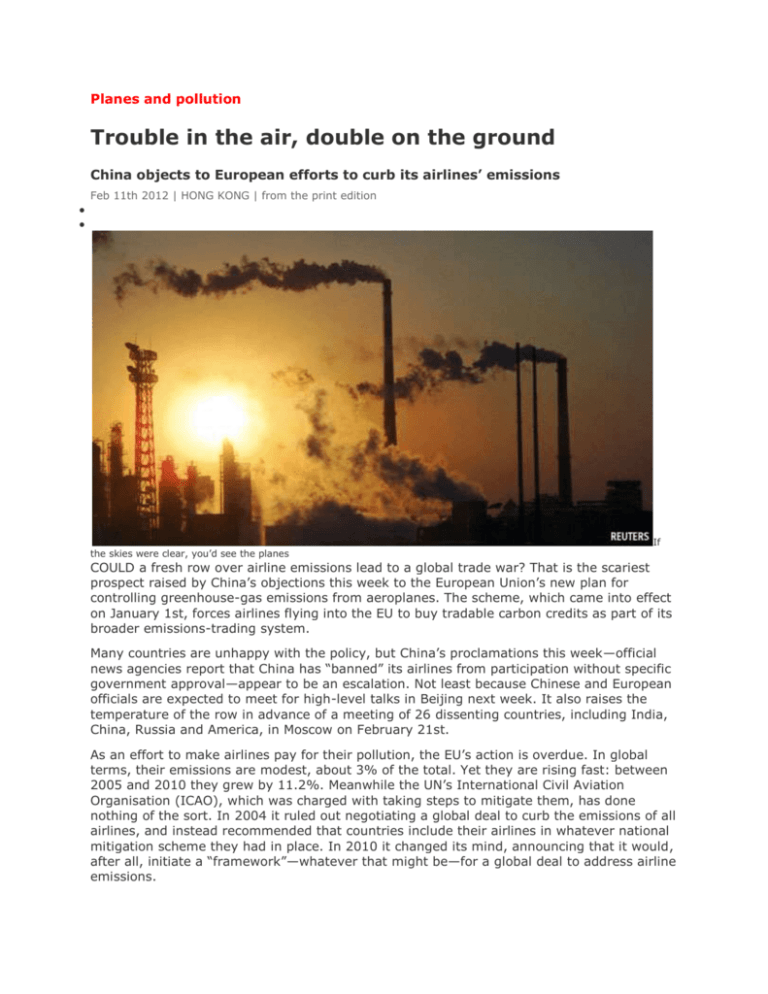
Planes and pollution Trouble in the air, double on the ground China objects to European efforts to curb its airlines’ emissions Feb 11th 2012 | HONG KONG | from the print edition the skies were clear, you’d see the planes If COULD a fresh row over airline emissions lead to a global trade war? That is the scariest prospect raised by China’s objections this week to the European Union’s new plan for controlling greenhouse-gas emissions from aeroplanes. The scheme, which came into effect on January 1st, forces airlines flying into the EU to buy tradable carbon credits as part of its broader emissions-trading system. Many countries are unhappy with the policy, but China’s proclamations this week—official news agencies report that China has “banned” its airlines from participation without specific government approval—appear to be an escalation. Not least because Chinese and European officials are expected to meet for high-level talks in Beijing next week. It also raises the temperature of the row in advance of a meeting of 26 dissenting countries, including India, China, Russia and America, in Moscow on February 21st. As an effort to make airlines pay for their pollution, the EU’s action is overdue. In global terms, their emissions are modest, about 3% of the total. Yet they are rising fast: between 2005 and 2010 they grew by 11.2%. Meanwhile the UN’s International Civil Aviation Organisation (ICAO), which was charged with taking steps to mitigate them, has done nothing of the sort. In 2004 it ruled out negotiating a global deal to curb the emissions of all airlines, and instead recommended that countries include their airlines in whatever national mitigation scheme they had in place. In 2010 it changed its mind, announcing that it would, after all, initiate a “framework”—whatever that might be—for a global deal to address airline emissions. Unconvinced, the EU decided to push ahead with its plan to make all flights into the EU subject to the emissions-trading scheme (ETS). This is now enshrined in European law. The only ways foreign governments could extricate their airlines from it would be to stop them flying into the EU, or make them subject to an equivalent mitigation regime of their own. Imperative or imperialism? The main objection to the EU’s policy is that it applies to air-miles clocked up outside European airspace. The EU argues that its approach is consistent with ICAO’s own guidelines and that it would be impossible to regulate otherwise. But the dissenters claim this infringes their sovereignty and breaks the terms of the Chicago Convention, which has regulated aviation since 1944. A group of American airlines therefore launched a legal challenge to the policy; but it was dismissed by the European Court of Justice in December. There was a precedent supporting the Europeans: American green laws insist that ships docking locally be double hulled, even though that forces ship owners to pay for unwanted double hulls on international waters en route to American ports. China also claims that the EU’s policy transgresses UN climate-change agreements which ordain that mitigation costs should be lower for developing countries than rich ones. Yet, even setting aside the difficult issue of how much of a free ride China can expect, the EU’s policy applies to individual companies, not countries, for which there is no such dispensation. It is a troubling spat. But there is at least time to negotiate a way out. The airlines are not due to be billed for their emissions until April 2013. Even then, they will have to pay for only 15% of them. Under the ETS, they are required to buy tradable permits for a gradually rising portion of their emissions: this year the EU will give the airlines permits to cover 85% of them. The airlines, naturally, say the cost will be onerous nonetheless. The China Air Transport Association, which represents China’s airlines, estimated the scheme would cost them 800m yuan ($127m) this year, and more than three times as much by 2020. It may well be less. EU officials say the costs of the scheme, if passed on to passengers, would add no more than around €2.50 ($3.30) to the price of a one-way ticket between Europe and China. By slapping ETS surcharges on tickets, as some non-Chinese airlines have done, they may even profit from the scheme. The best solution would be through the ICAO. In November it resolved to accelerate steps to introduce its own mitigation efforts. It has drawn up a shortlist of options, including a carbon tax or cap-and-trade scheme that would apply to all airlines. China’s rulers should meanwhile note that, besides cooking the climate, aviation also causes local pollution, which poor countries suffer more grievously than rich ones. Researchers at the Massachusetts Institute of Technology and Cambridge University have estimated the impact on the ground of emissions from aircraft flying at cruise altitude (about 35,000 feet), a problem typically ignored by regulations. They have shown that emissions of nitrous oxides (NOX) and sulphur oxides (SOX) combine with gases already in the atmosphere to create very fine particles that are especially dangerous to human health. Such pollution is a huge problem in China (see article). The researchers found that though most aviation emissions currently occur over North America and Europe, about 3,500 of the 8,000 resultant premature deaths per year happen in China and India. Many variables explain this, but the most important is that farming in these heavily populated countries (unlike that in America) emits huge amounts of ammonia. This interacts with the NOX and SOX to produce the dangerously small particulate pollution that leads to premature deaths. With air travel in China booming, the worry is that this underreported public-health problem will also boom.


